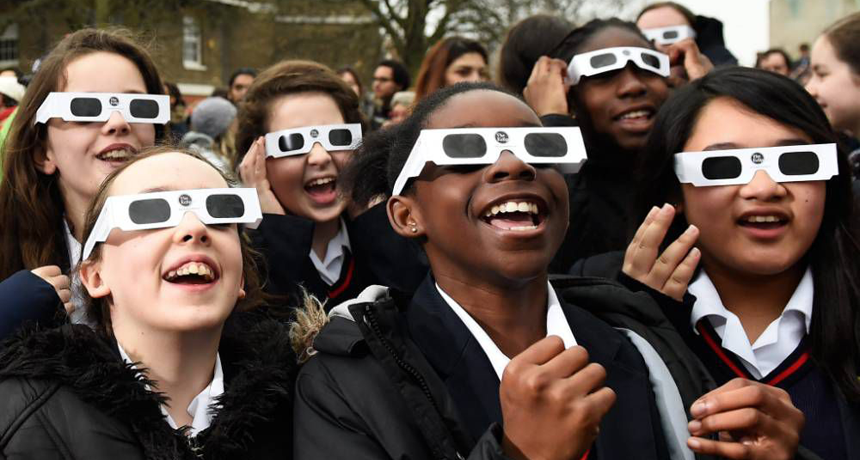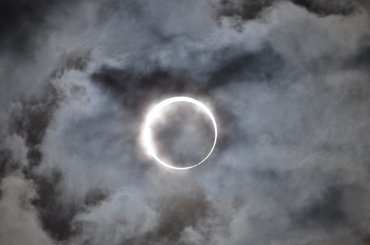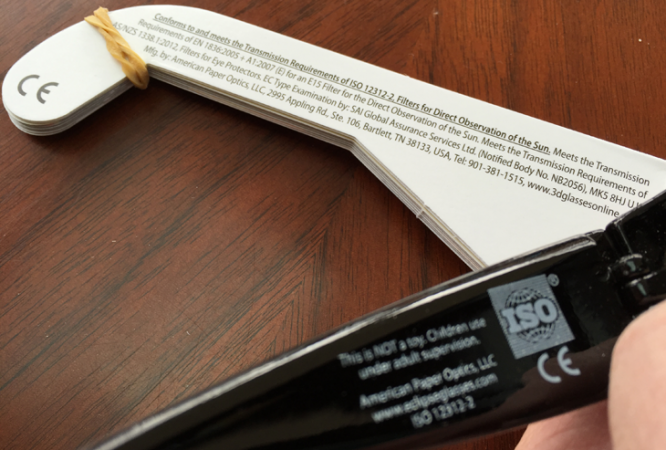How to safely watch a solar eclipse
Certified eyeware will protect against permanent harm to the eyes

Students keep their eyes safe with certified glasses when looking up at the sun.
American Paper Optics
Some people have been willing to travel halfway round the world to see a solar eclipse. But for many in the United States, that won’t be necessary on August 21, 2017. They’ll only need to walk outside to gaze at a partial or full eclipse of the sun. However, to view such a spectacle safely, they will need to take some special steps.
People have “watched eclipses in all history,” says Jarita Holbrook, a fellow at the National Science Foundation in Washington, D.C. (This physicist usually works at the University of the Western Cape in Cape Town, South Africa.) Ancient people “knew that the moon was covering up the sun,” she says. And they made up myths to describe why this happened. Some described the sun and moon as fighting. Others talked about a marriage between the sun and moon.
But just gazing up at the sun is a bad idea. Its intense light can easily damage eyes. “You have to wear your protective glasses before totality — before the moon totally blocks the sun,” warns Shadia Habbal. She’s an astronomer at the University of Hawaii at Manoa. Once totality happens, you must put the glasses back on just before the moon moves to let light through again. And people watching a partial eclipse must keep their glasses on throughout the entire event.
The eyes have it
The sun’s electromagnetic energy includes several types of radiation. Some of that is visible light. It’s why you see the sun. But there’s also ultraviolet light. It has wavelengths shorter than those of visible light, close to violet on the spectrum. You can’t see this radiation, but it can cause sunburn, DNA damage and eye injury. The sun also emits infrared radiation. It has longer wavelengths than red light and transfers heat.
If someone looks directly at the sun, its energy can harm light-sensitive cells called rods and cones. They’re found on the retina at the back of the eye. Harm to those cells can happen without warning. That part of the eye has no pain cells.
“The primary danger is photochemical,” says Rick Fienberg. He’s an astronomer in Boston, Mass., with the American Astronomical Society. “Intense sunlight can cause chemical reactions to occur in the retina that damage or destroy the rods and cones.” That harm could lead to partial or total blindness. And such damage can be permanent.
“The light interacts with materials within the cell,” explains Ralph Chou. He’s a vision scientist at the University of Waterloo in Ontario, Canada. These reactions produce molecules such as peroxide (Puhr-OX-ide) and hydroxyl (Hy-DROX-uhl) radicals. Those chemicals can easily swipe electrons from nearby atoms or molecules. And resulting cell-killing free-radical reactions can “very rapidly chew up the internal organelles of the cell.” Organelles are parts of a cell that do specific jobs. Depending on the harm, damage to them can be either temporary or permanent.

But that’s not all.
“The intense light and heat can actually cook the retina,” Feinberg notes. That could lead to a permanent blind spot. And looking at the sun through binoculars or a telescope could worsen the risk. Their lenses focus the sun’s energy on the eye. The resulting harm could occur almost instantly.
The danger is no less when the moon starts to block out the sun. “Whatever is not covered up by the moon is every bit as intense as it is outside of an eclipse,” says Chou. Indeed, as the visible light gets less bright, the eye’s muscles respond to let more light in. This can actually boost the danger.
Get certified
Regular sunglasses can’t protect eclipse viewers, even if their lenses are very dark. Homemade filters can’t guarantee safety either. Fortunately, there are ways to see a solar eclipse and keep eyes safe. The key is to get glasses or shields that are certified to meet an international standard known as ISO 12312-2. Chou helped develop it.
“The lens material is specially made to filter out 100 percent of harmful ultraviolet rays, 100 percent of harmful infrared rays and 99.999 percent of intense visible light,” explains Paulo Aur. Aur heads up operations at American Paper Optics in Bartlett, Tenn. That company and several others make glasses and viewers that have been tested by independent labs to meet the international standard.
The filter must be dense enough to provide protection, explains Chou. Yet viewers want a sharp solar image. So the filter must allow very little scattering of whatever light comes through. Otherwise, you’d notice “a wash-out of the image,” he says.
Certified eclipse glasses have plastic filters with light-absorbing material inside the plastic. Or, they can have a metal coating on the plastic that provides the protection. “They are both safe if they have been ISO-certified and are used properly,” Aur says. Glasses from his company have black polymer lenses with a silver coating outside. That gives an orange tint to the sun’s image and reflects more heat from your face, he says. Mylar lenses offered by some other companies give the sun a white tint.
Either way, the glasses are inexpensive. Schools and other groups can get fun designs for less than $1 per unit in orders of 100 or more. They can be bought online in smaller quantities for only a couple of dollars each. Some local science museums will give them away for free.
“Plan well in advance,” says Holbrook. “You need to have your eclipse viewing glasses at least two weeks before.” Otherwise, you may be disappointed if supplies run out.
Wherever you get your eclipse glasses, check them out before using them. Make sure the back shows that they are certified to meet the ISO standard. And make sure there are no scratches or holes.
Story continues below image.

Use common sense when you use the glasses. Turn away from the sun before putting them on or taking them off, says Habbal. And because they’ll make it very hard to see anything other than the sun, don’t walk around while wearing them!
Watch for other changes that also happen during an eclipse, says Holbrook. “It’s like nothing you’ve ever seen before in your life.” Some flowers will fold up as the sun’s light dims. Animals will scurry as if night is falling. At the same time, light filtering through trees will cast images of little crescent suns on the ground. The spaces between leaves will act like a pinhole camera. (A pinhole camera is another safe option for viewing the eclipse, because you never look directly at the sun.)
And be thankful you won’t have to take the same precautions that Habbal’s group needed in March 2015. That year, her science team went to Spitsbergen to study an eclipse. (That’s an island east of Greenland and north of the Arctic Circle.) “We had to wear warm clothing,” says Habbal. “But the biggest danger was the polar bears. The people of the town require that any group has some people who are trained to carry rifles in case of a bear attack.”







